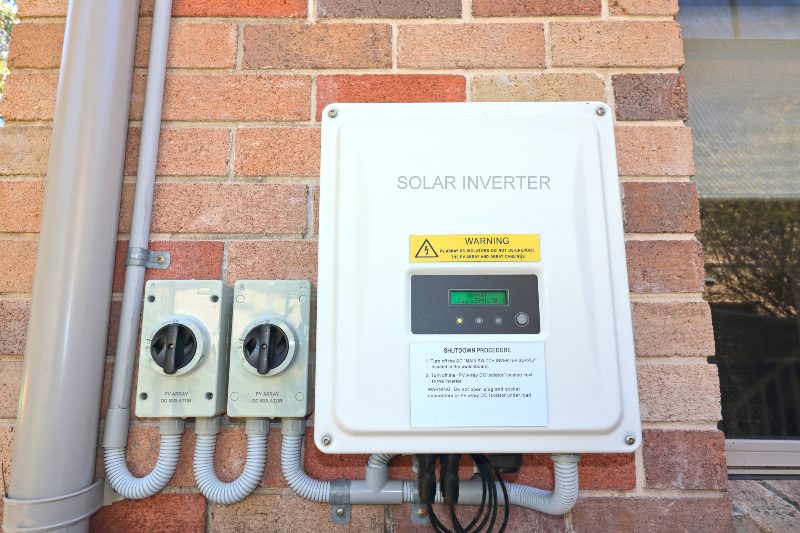All you need to know about Solar Inverters
Benefits, Cost & How does Solar Inverter Work
Harnessing the sun to produce clean, sustainable energy is the key to powering the future. This guide explores one essential component of any solar power system known as the solar inverter. Here, you’ll learn how solar inverters work, the types of inverters available, the benefits of this component, and the associated costs.

How Does a Solar Inverter Work?
A solar inverter’s primary function is to transform direct current (DC) electricity generated by your solar panels into alternating current (AC) electricity needed to power the lights and appliances in your home. This transformation process is crucial because without it, the energy harnessed from the sun would be useless.
The inverter also acts as a bridge between your solar-powered home and the grid. This connection point ensures uninterrupted power, regardless of how much energy your solar panels generate at any given moment.
Types of Solar Inverters
Several styles of solar inverters are available, each designed with unique features to optimize solar energy utilization.
String Inverters
Also called central inverters, string inverters connect to the entire array of solar panels, making the collectively produced DC power available to your home as AC power. This type of inverter is a common and economical choice, ideal for solar power systems that offer consistent performance from one panel to the next. Just be aware that the weakest panel in the array may limit the entire system’s efficiency, similar to how a single faulty bulb can affect a whole string of Christmas lights.
Microinverters
Unlike centralized string inverters, microinverters work at the individual level, converting DC to AC for each panel independently. This design significantly reduces the impact of a single panel’s performance on the entire system. While microinverters generally cost more, they provide better efficiency, especially for systems with partial shading or different panel orientations.
Power Optimizers
Bridging the gap between string inverters and microinverters are power optimizers. These devices are installed on each solar panel, similar to microinverters, but they don’t convert DC to AC at the source. Instead, they “optimize” the DC power before sending it to a central inverter for conversion. This mixed approach enhances the efficiency and flexibility of your solar power system.
Hybrid Inverters
Also known as multi-mode inverters, hybrid inverters are an all-in-one solution capable of managing power from both solar panels and battery storage systems. They offer the flexibility to use solar power during the day or store excess electricity for use at night or during power outages. While pricier, their versatility in different scenarios makes hybrid inverters increasingly popular, especially among homeowners with solar batteries.
Solar Inverter Benefits
Solar inverters offer many benefits and functions beyond simply converting DC to AC, which makes them essential for any solar energy system.
Maximize Energy Production
Microinverters and power optimizers, in particular, are designed to maximize the energy output from each solar panel. By working on a panel-by-panel basis, they ensure that the underperformance of one panel doesn’t affect the entire array, helping you to get more out of your solar investment.
Monitor System Output
Solar inverters often come equipped with monitoring capabilities. This feature lets homeowners track real-time solar panel performance, providing insight into energy production, energy consumption, and arising issues.
Communicate with the Grid
When your grid-tied solar power system produces more electricity than you consume, the excess energy feeds back into the grid. Similarly, when your power needs exceed your solar system’s production, the grid supplies the shortfall. This bi-directional flow of electricity, enabled by the solar inverter, allows for effective grid-tied operation.
Detect Hazardous Faults
Solar inverters enhance solar panel safety by detecting system faults, including electrical shorts or power surges. When such anomalies arise, the inverter automatically disconnects the solar array from the grid to prevent further damage.
Solar Inverter Cost
Prices vary based on solar inverter type, size, brand, and quality. In general, inverters cost $0.10 to $0.50 per watt. A cost-effective string inverter may be priced at $1,000 to $1,500 for a medium-sized installation, while costlier microinverters may be twice as much for the same size system. When choosing a solar inverter, it’s crucial to weigh the upfront costs, long-term benefits, and potential energy savings.
Optimize Your Solar Panel System with a Solar Inverter
Kapital Electric, Inc. provides solar inverter installation in Chicago and the surrounding suburbs to help homeowners optimize their solar panels. With over 25 years of experience, you can trust us to help you make important decisions about your solar array. Our energy efficiency experts are committed to providing the best solutions to meet your energy needs, reduce your electricity costs, and add value to your home.
Whether you’re looking to install new solar panels or upgrade your existing installation, your project begins with Kapital Electric, Inc. Call us today at (630) 833-2389 to request a free onsite evaluation
